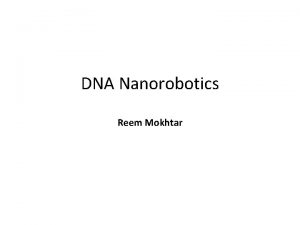CLS 223 Reem Alkhamis Email ralkhamisksu edu sa



















- Slides: 19

CLS 223 Reem Alkhamis Email: ralkhamis@ksu. edu. sa 3 rd floor/ office # 125

Lecture # 9 Disturbances of Growth

Disturbance of growth are divided into 1) Congenital anomalies (Developmental disorders) 1) Atrophy 2) Hypertrophy 3) Hyperplasia 4) Metaplasia 5) Dyslasia 6) Neoplasia

Cellular response to stress may be adaptive or non adaptive. 1) Change in cell number, size, type 2) Inflammation and repair 3) Immune response Adaptive hypertrophy Non-adaptive (cell injury-----cell death) Dysplasia hyperplasia neoplasia Atrophy Degeneration Metaplasia Reversible Necrosis, apoptosis & gangrene Reversible* / Irreversible *to a certain limit

1) Congenital anomalies : Causes: -Genetics. -Environmental: Exposure of the mother during pregnancy to X-ray, Drugs, toxins. . ect Examples of Congenital anomalies : • Agenesis or Aplasia: Complete failure of an organ or tissue to develop. The organ is totally absent. • Hypoplasia: Failure of an organ to achieve the full size.

• Failure to fuse (E. g. Cleft palate, cleft lip) • Failure to separate (In toes or fingers) • Supernumerary organs (E. g. more than 5 toes) • Failure to canalize (E. g. esophagus)

6) Dysplasia Disordered epithelial cell growth leading to formation of tissue with various size, shape and appearance. • The Variation in caused by: 1 - Chronic irritation. 2 - Chronic inflammation. • It might lead to neoplasia (tumors) (malignancy).

7)Neoplasia (tumors) • Definition: Self-controlling growth formed by the unlimited multiplication of abnormal cells in one of the body tissues or organs. • General characters of tumors: 1) The growth is unlimited and independent of the normal process of body growth. 2)Cells of tumor have supporting stroma of fibrous tissue and blood supply derived from the host. 3)The tumor mainly forms a mass which has no useful function. The activity of the tumor is spent mainly in multiplication. However, functional activity might be present e. g. in tumors of endocrine glands. This functional activity is not needed and harmful. 4)Tumors are classified according to their behavior into benign and malignant.

• Tumor = Swelling. • It ends with (oma) e. g. Retinoblastoma, lipoma, carcinoma Oncology: is the study of neoplasms and their treatment.

Characteristics: Benign tumors Malignant tumors mass Small size, spherical shape, with sharply defined margin Reach large size within short time, different shapes, irregular margin Fibrous Capsule: formed by normal tissue around the tumor Present Absent Cells type and arrangement Cells resemble the tissue of origin regarding cell type and arrangement (differentiation) Fail to reproduce the exact type and pattern of parent tissue (Loss of differentiation) Cell size Cells are usually small and similar in size and shape. Pleomorphism ( change in size and shape of the cells) BV Few blood vessels. More blood vessels


Behavior: Benign tumors Malignant tumors Rate of growth: Slow Rapid Mode of growth and Effect on the host By expansion, Compress on the surrounding tissue to form room for itself without destroying the surrounding tissue, so it isn’t dangerous except when it compresses vital structures as the brain, spinal cord, heart. . . By Infiltration and destruction of all the surrounding tissues. Malignant cells push themselves in between surrounding normal cells in all directions and take most of their nutrients, so normal cells undergo necrosis which usually kills the patient even if it was in the skin localization Localized at the site of origin. Not localized at site of origin but metastasis occurs. Recurrence If well removed, there is no Even after surgical removal it recurrence (Good prognosis) often reoccurs (bad prognosis)

Malignant tumor Carcinoma sarcoma Definition Tumor of epithelial tissue Tumor of mesenchymal tissue: made of bone, cartilage, fat, muscle, vascular, or blood tissue Incidence More common Less common Age Middle and old age (40 -60 ys) Adolescent and early adult life (10 -20 ys) Rate of growth Slower than sarcoma More rapid than carcinoma Mode of growth More by infiltration than by expansion Is by expansion and by infiltration. Gross picture Hard mass Soft mass Microscopic picture Carcinoma cells are arranged in groups, separated by fibrous stroma, with less numerous blood vessels. Sarcoma cells are arranged singly, separated by scanty amount of fibrous stroma with numerous blood vessels.

Factors causing cancer Cancer is a complex disease with many possible causes. 1) Hereditary: E. g. breast cancer 2)Organisms: mostly viruses can lead to cancer e. g. Human papilloma virus (HVP) is strongly linked to cervical cancer. 3)Carcinogens: Agents natural or synthetic capable of causing cancer E. g. Smoking can lead to lung cancer. Radiation exposure. .

Effects of cancer growth on body function 1) Destruction & replacement of normal tissue by neoplastic growth lead to altered function of that tissue. 2) Compression on BV lead to ischemia, necrosis. Compression on surrounding hollow viscera can lead to their obstruction. 3) Inappropriate production of hormones (in case of cancer in any of the endocrine glands). 4) In some tumors, there is abnormal production of coagulation factors and this increase the risk of thrombosis. 5) In some tumors, there is bleeding and/or decrease in RBC production, and leads to anemia. 6) Metastatic invasion of bone that occurs in advanced stages of the tumors leads to bone destruction. 7) Pain occurs in some tumors due to compression on nerve ends or liberation of pain mediators.


Diagnosis of cancer

2. Pap smear (cervical smear): obtaining superficial cells from the cervix and examining them to detect abnormality.

3. Biopsy: obtaining deep cells: -needle aspiration -Using endoscope 4. Others as x-ray, blood film




































